According to the Gospels, Jesus’ earthly ministry centered around the Sea of Galilee. While important events occurred in Jerusalem, the Lord spent most of the three years of his ministry along the shore of this freshwater lake. Here he gave more than half of his parables and here he performed most of his miracles.
Northwestern shore of the lake from Mt. Arbel
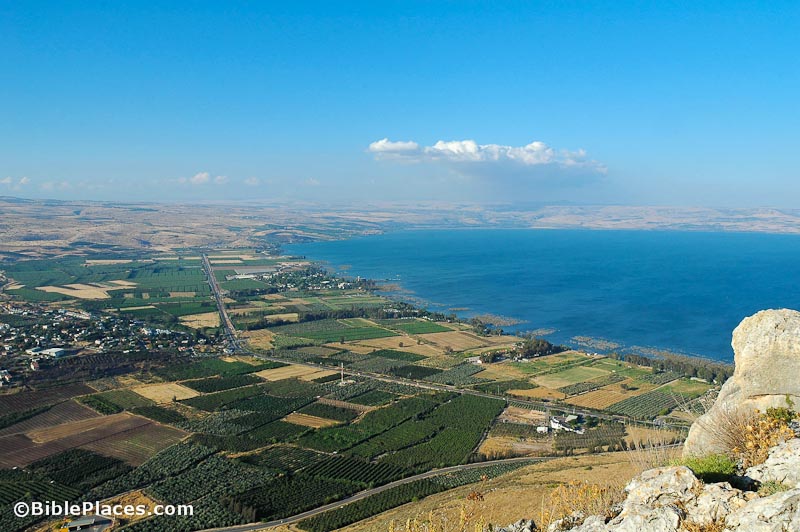
The Plain of Gennesaret on the northwestern shore of the Sea of Galilee sits between Capernaum and Magdala and was surely crossed by Jesus and his disciples many times. Photograph by Todd Bolen. Photo © BiblePlaces.com
Jesus’ “hometown” throughout his ministry. Three of his disciples hailed from Bethsaida, located only a few miles from Capernaum. These two cities, together with Chorazin two miles inland from Capernaum, were condemned by Jesus for receiving much but believing little. A famous follower of Christ was Mary of Magdala, a town on the lake’s western shore. Early Christians hallowed the lakeside, building churches commemorating the feeding of the five thousand, the Sermon on the Mount, the primacy of Peter, and the house of Peter.
Capernaum from the south
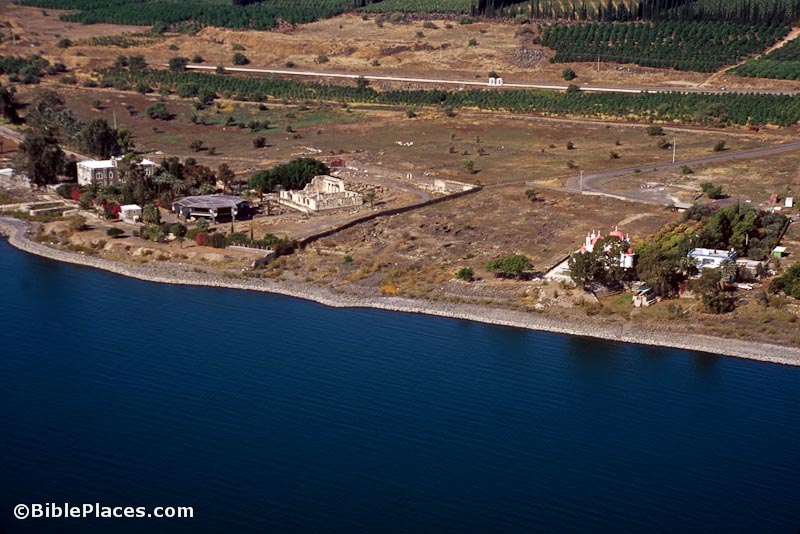
Capernaum sits on the northwestern shoreline of the Sea of Galilee. Today the area on the west (left) is owned by the Franciscans and the land on the east is the property of the Greek Orthodox Church. Photograph by Todd Bolen. Photo © BiblePlaces.com
Names
Known in the Hebrew Bible as Chinnereth, Josephus used the Hellenized form of this name, Gennesar or Gennesaritis, most frequently in his writings. Luke uses this term, but the more common New Testament designation is the familiar “Sea of Galilee.” John twice refers to it as the “Sea of Tiberias.” Pliny notes that some called it Tarichaeae after the name of another town along its shore.
The Sea of Galilee is 700 feet below sea level
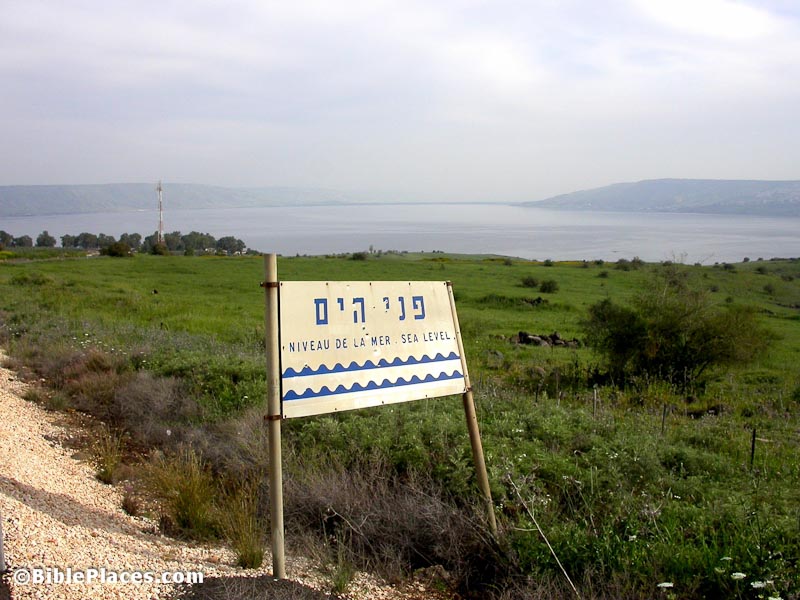
The Sea of Galilee sits 700 feet (210 m) below sea level, as is apparent from this sign above the north shore. Photograph by Todd Bolen. Photo © BiblePlaces.com
Dimensions
The Sea of Galilee is the lowest freshwater lake on earth at approximately 700 feet (210 m.) below sea level. At its widest points, the lake measures 13 miles (21 km.) from north to south and 7.5 miles (12 km.) from east to west. The lake’s total area is 64 sq. miles (170 sq. km.) and its circumference is about 32 miles (51 km.). Its deepest point has been variously estimated between 140 and 200 feet (44-60 m.) and its capacity is approximately one hundred billion cubic feet (three billion cu. m.).
Tabgha shoreline from boat
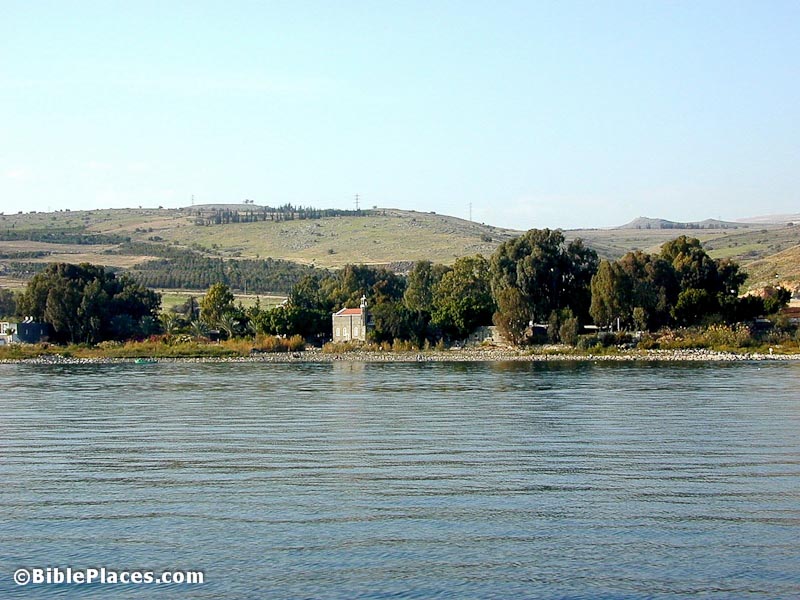
Peter may have had a similar view to this when he heard a man on shore tell him to cast the net on the right side of the boat (John 21). Heptapegon (Tabgha) is the traditional place of the “last breakfast.” Photograph by Todd Bolen. Photo © BiblePlaces.com
Today
Yam Kinneret, as it is known to Israelis, is the primary source of water for the nation and as such its outward flow to the Jordan River is carefully regulated by the government. The Degania dam was built in 1932 to control the water level and when the lake fills after good winter rainfalls, the Sea of Galilee is about one meter higher than it was in the time of Christ. This is apparent from the level of the harbors that have survived from the first century.
Jordan River entering the Sea of Galilee
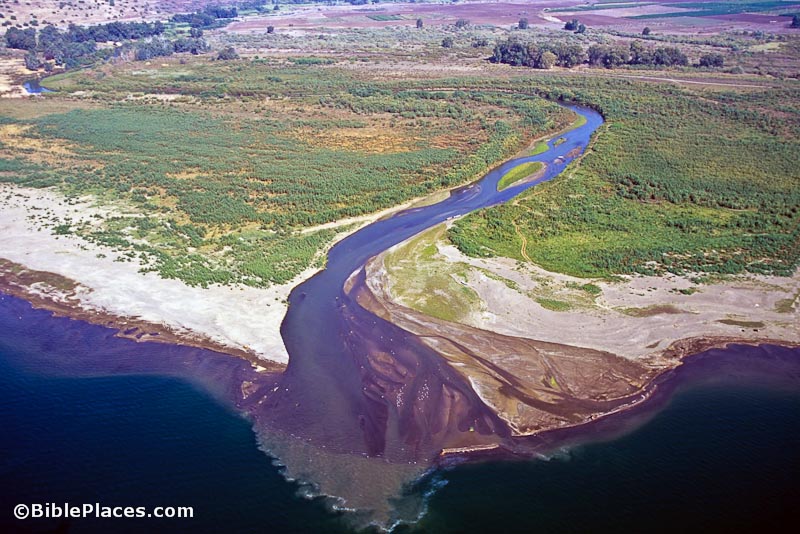
The Jordan River enters the Sea of Galilee not far from ancient Bethsaida. Photograph by Todd Bolen. Photo © BiblePlaces.com
The Jordan River is the main source of water for the lake, supplying about 75 percent of the lake’s annual intake. Direct rainfall provides another 8 percent and the remainder comes from springs and wadis in the area. Numerous springs are located around the Sea of Galilee, particularly along the northwestern shore, but because of the higher salinity of these waters, today many of these springs are diverted to flow directly into the Jordan River south of the lake.
The Sea of Galilee from the east

This view from the eastern side shows nearly the entire extent of the Sea of Galilee. Click to enlarge. Photograph by Todd Bolen. Photo © BiblePlaces.com
Climate and Storm Patterns
The climate around the Sea of Galilee is temperate year-round, largely owing to its elevation below sea level. The average mean temperature in August is 88° F (31° C) and January’s average mean temperature is a mild 57° F (14° C). The relative humidity averages 65 percent and the lake receives about 16 inches of rain annually.
First Century boat reconstruction
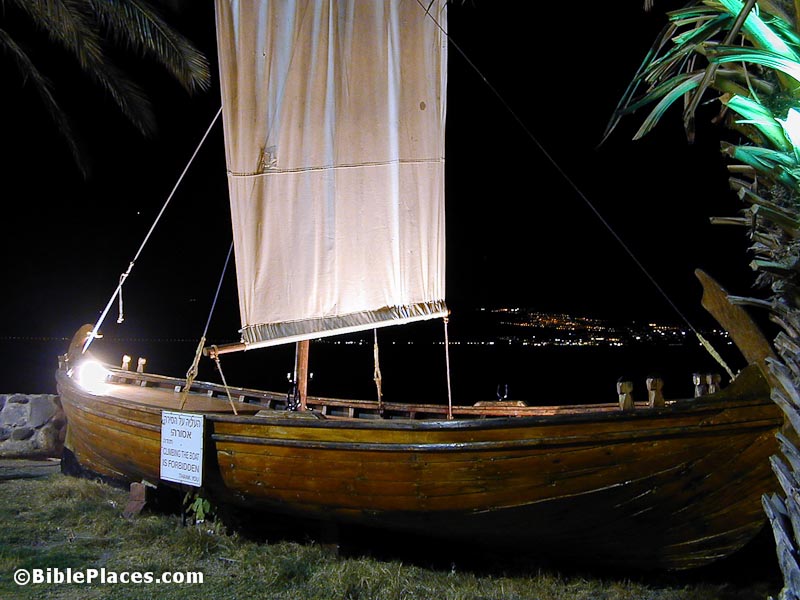
A reconstruction of a first-century boat based on an ancient boat excavated along the northwestern shore of the Sea of Galilee. Photograph by Todd Bolen. Photo © BiblePlaces.com
The Sea of Galilee is known for its violent storms, which can come up suddenly and be life-threatening for any on its waters. These tempests are caused by the situation of the lake in the Jordan Rift with steep hills on all sides. The cooler air masses from the surrounding mountains collide with the warm air in the lake’s basin. Winds sometimes funnel through the east-west-oriented valleys in the Galilean hill country and rush down the western hillsides of the lake. The most violent storms, however, are caused by the fierce winds which blow off the Golan Heights from the east. One such storm in March 1992 sent waves ten feet (3 meters) high crashing into downtown Tiberias and caused significant damage to the city.
Ancient harbor at Tabgha
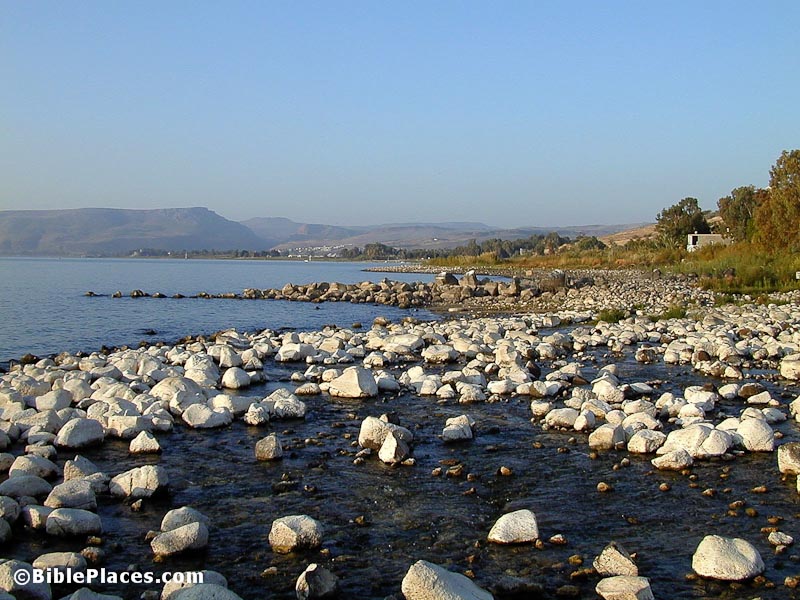
The remains of the ancient harbor of Heptapegon (Tabgha) are visible when the water level of the Sea of Galilee is low. Photograph by Todd Bolen. Photo © BiblePlaces.com
Harbors and Fishing
Aside from a few natural inlets on the northern side, the Sea of Galilee does not have any natural harbors. The fishing industry which grew up around the lake as early as the Early Bronze Age (3300-2300 B.C.) resulted in the construction of artificial breakwaters. The first ancient harbor was discovered at Kursi in 1970 and since then fifteen additional harbors have been identified. Most assume that these were in use during the flourishing first century A.D. and it is certain that Jesus and his disciples were familiar with many of them. The harbors that the disciples most likely would have frequented were those at Capernaum, Tabgha, Gennesar and Magdala. The Capernaum harbor is particularly noteworthy as it extended for more than 2500 feet (800 m.) along the shore, a length greater than that of the city.
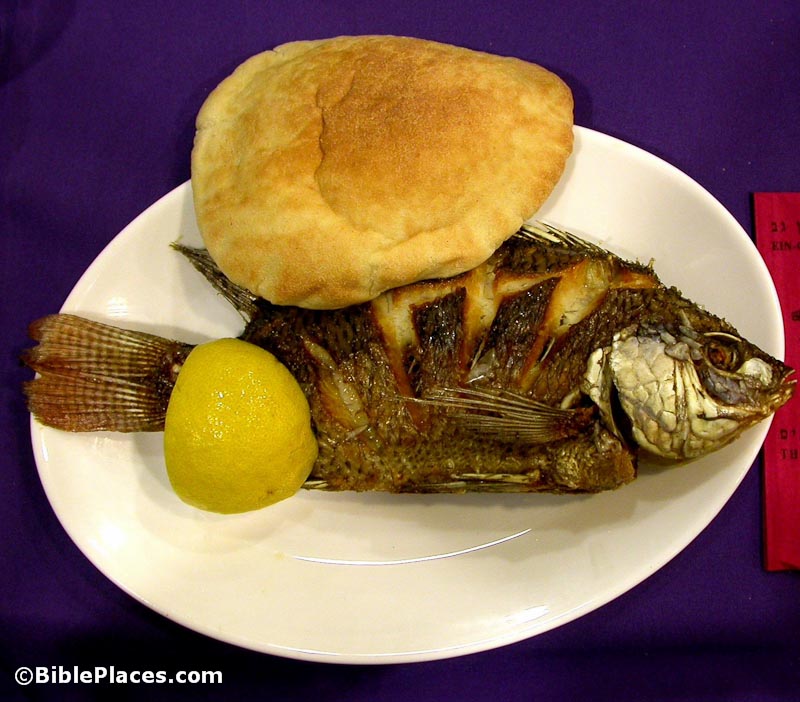
The fish traditionally known as “St. Peter’s fish” is a tasty and popular fish native to the Sea of Galilee. Photograph by Todd Bolen. Photo © BiblePlaces.com
“St. Peter’s Fish”
The presence of numerous and large harbors attests to the commercial importance of the lake during Jesus’ life. (By contrast, today there are only five harbors on the lake and these are used primarily for boats for tourists.) Magdala apparently was the industrial center of the fishing trade, and fish to be exported were first salted here. Today thirty-five species of fish make their home in the waters of the Sea of Galilee and the Jordan River, but three types seem to be most common in the New Testament record. The sardines were a staple of the locals’ diet and these were probably the “two small fish” which Jesus used to feed the multitude. The musht fish has a long dorsal fin which resembles a comb and is today popularly known as “St. Peter’s fish.” This tasty fish could measure up to a foot and a half long (0.5 m.) and weigh 3.3 lbs (1.5 kg.). The third type is the catfish, which is not considered kosher because of its lack of scales. These probably would have been brought to mind when Jesus referred to the bad fish that would be thrown away (Mt. 13:48).
Sunset over the Sea of Galilee
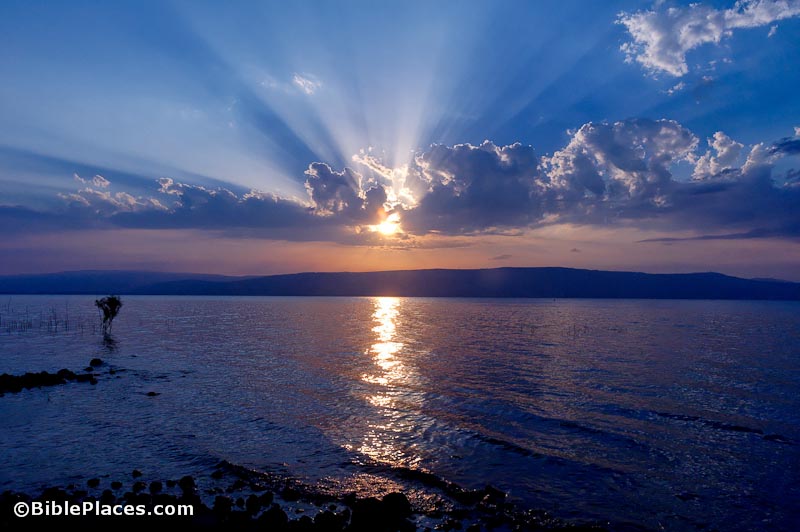
The sun sets over the Sea of Galilee on a beautiful October day. Photograph by Todd Bolen. Photo © BiblePlaces.com
Jesus’ Ministry
The significance of the Sea of Galilee in Jesus’ ministry is indicated by the fact that some of the first and some of the last events in his ministry occurred here. Shortly after the temptation, Jesus traveled to Capernaum with his family (Jn. 2:12). Later Jesus would live in Capernaum and call four of his disciples from among the fishermen in the area (Mt. 4). While he performed many miracles at points along the lakeshore, two of his most dramatic miracles were done on the water itself when he stilled the storm (Lk. 8:22-25) and walked on the water (Mark 6:47-52). Following his resurrection, Jesus cooked breakfast on the shore for seven of the disciples (Jn. 21).
The rabbis declared of the Sea of Galilee that, “Although God has created seven seas, yet He has chosen this one as His special delight.” Certainly Jesus must have felt the same way.
Paid Content
Premium Members and Friends of JP must be logged in to access this content: Login
If you do not have a paid subscription, please consider registering as a Premium Member starting at $10/month (paid monthly) or only $5/month (paid annually): Register
One Time Purchase Rather Than Membership
Rather than purchasing a membership subscription, you may purchase access to this single page for $1.99 USD. To purchase access we strongly encourage users to first register for a free account with JP (Register), which will make the process of accessing your purchase much simpler. Once you have registered you may login and purchase access to this page at this link:






























































































